Nose Color
PetPom
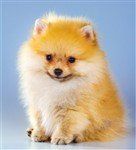
The
Pomeranian
Information
Center
Pomeranian Nose Color
Overview
The adorable Pomeranian breed can be found in an amazing array of coat colors, however the nose color of the Pomeranian is also varied and quite interesting as well. With nose color, there is so much more to this than just the simple wording of the AKC breed standard.
In this section, we are going to go into all of the fun and remarkable details of possible Pomeranian nose colors, both those accepted and not accepted and of course, thanks to the amazing Members of PetPom, we have lots of adorable photos to go along with this.
First, a Brief Summary of the Amazing Canine Nose
The canine nose is made of skin, however a dog's body has 5 layers of skin and the nose has only 3 layers. So, while it is sometimes referred to as leather (it is not), and assumed to be tough and strong, the nose is rather delicate.
This is one reason why dry skin on the nose can quickly develop into issues (please regularly use a quality nose butter to keep it healthy).
The outer layer, which has grooves, is called the stratum corneum. The pattern of grooves (ridges and dimples) is unique to each dog and no two are alike; one could say that a nose print is the canine equivalent of human fingerprints.
Though it is normal for a dog's nose to fluctuate between dry and moist throughout the day, the wetness on the nose does help a dog in picking up the direction of where a scent is coming from.
You may already know that canines have a much better sense of smell than humans (on average, 100,000 times better) due to the number of scent receptors that are present.
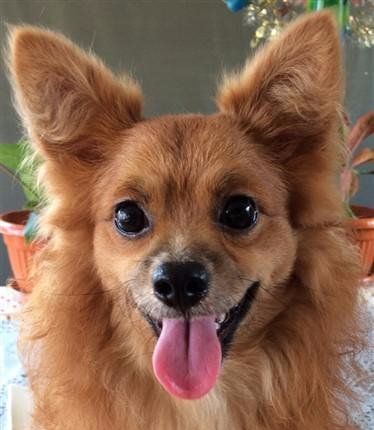

Java, at 1 year and 1 month old
Photo couresty of Juvy Yee
Humans have only 5 million. It is said that canines have much more: 220 million; however, this is a bit misleading, as it is a figure given for the average of all dog breeds.
You'll be interested to know that the number of scent receptors vary from breed to breed. While it is mostly due to the size of the dog's nose, it is also due to selective breeding.
In regard to nose size, the scent receptors are located in the bony ridge inside of a dog's nose and therefore dogs with longer muzzles have more room for these scent-detecting cells. The Bloodhound, due to both size and selective breeding, has 300 million. The German Shepherd has 225 million.
While we cannot find any exact figure for the Pomeranian breed, it is safe to say that the number of scent receptors the Pomeranian has is close to that of smaller dogs, like the Dachshund that has 125 million. And this is still quite amazing!
An interesting article in Science Magazine, talks about a canine sniffing study
done by a mechanical engineer at Pennsylvania State University, University Park, named Brent Craven. His team outfitted a Pomeranian and 6 other breeds (including a Sheltie–Husky mix, a German Shepherd and a Labrador Retriever) with special muzzles to measure how they used their noses to sniff.
The Pomeranian performed much the same as the other dogs. They sniffed different things (peanut butter, tuna, etc.) at a rate of 5 sniffs per second. It's amazing to know that the equipment proved that each nostril independently pulled in a different smell.
Now, On To Pomeranian Nose Colors
Now that we know a bit more about the incredible canine nose, let's dive into the topic of which color noses are possible with the Pomeranian breed. There are some things to understand before we start showing photos. And this will help owners who may be unsure of what color nose their Pom really has.
The AKC Breed Standard
- Though there is much more to nose color than what the standard tells us, let's see what the standard says: Nose
- Pigment is black except self-colored in chocolate, beaver and blue.
What this means:
There are 4 accepted
nose colors of the Pomeranian:
- Black - If the nose is not chocolate, beaver or blue, it 'should' be black. All Poms except brown (chocolate), beaver (varying shades of tan) and blue (a super dark steel navy or 'washed out' diluted black) 'should' have black noses and if not, it is be considered a fault (much more ahead).
Self-colored noses:
The term of 'self-colored' means that Pomeranians with chocolate, beaver or blue coats will have noses (and paw pads, lips and eye rims) of that same color. This said, there are some Pomeranians that have chocolate, beaver or blue noses BUT do not show any of those colors in their coat (and of course, we have more on this ahead). Moving forward, remember that the eye rim color matches the nose, as this helps you determine nose color.
So, the 3 self-colored noses are:
- Chocolate - In many, but not all cases, the coat will be brown. This can vary from light to dark brown, though most are medium to dark. If the nose is dark brown (chocolate colored), even if the coat seems light, the Pomeranian will be a chocolate.
Other possible coat colors with a brown nose (though these will NOT be self colored) include red and orange and many parti colored Poms that hold red or orange.
- Beaver - Beaver is a diluted (light) chocolate and therefore, the dog holds a dilution gene (d). With other breeds, this color is referred to as liver. A Pom with a beaver colored nose will have a nose that is a light brown (but this varies a lot, as we will see in a moment).
In many cases, some will refer to this as pink, since it can have a particular hue that can appear to have a pink sheen. Many Pomeranians with beaver noses will have beaver in the coat. If the beaver does not show, but the nose is beaver color, this means that genetically the Pomeranian is beaver. And this is something to keep in mind when breeding.
- Blue
- Blue is a dilute black. A Pomeranian with a blue nose will (in most cases) have a blue coat. And, as mentioned, eye rims, lips, and paw pads as well. This, compared to other nose colors, is very rare.
One last thing... A dog may be dilute (dd) or
carry the dilute gene (dD). This means that two Pomeranians can be paired with neither
showing beaver or blue, but
if each has a hidden dilute gene (dD), any number of pups in the resulting litter may show that dilute color.
Pomeranians with Black Colored Noses
This is the most common nose color seen with the Pomeranian breed, though that does not take anything away from how beautiful it is. When the nose is black, other skin points should be as well. This includes the eye rims (which makes the eyes look very big, since most Poms have dark colored eyes), lips and paw pads.
With black noses, any moisture will be very apparent, making the nose super shiny. And in return, any dryness will show easily as well.
A special note to owners whose Pom USED to have a black nose:
In cases when the top layer is damaged, the 2nd layer is pink... so it's easy for a black nose to turn pink. There can be acute damage, such as a burn from the sun that caused the top layer to peel off, or it can be a matter of slower damage over time.
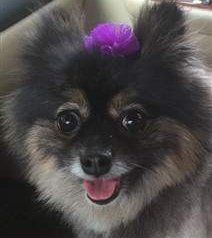
Lola, 7 years old
Photo courtesy of Rosi Lara
Pomeranians with Black Colored Noses
This is the most common nose color seen with the Pomeranian breed, though that does not take anything away from how beautiful it is. When the nose is black, other skin points should be as well. This includes the eye rims (which makes the eyes look very big, since most Poms have dark colored eyes), lips and paw pads.
With black noses, any moisture will be very apparent, making the nose super shiny. And in return, any dryness will show easily as well.
A special note to owners whose Pom USED to have a black nose:
In cases when the top layer is damaged, the 2nd layer is pink... so it's easy for a black nose to turn pink. There can be acute damage, such as a burn from the sun that caused the top layer to peel off, or it can be a matter of slower damage over time.
Also, other elements can cause a black nose to become discolored. In some cases, this can be reversed. We will go into more detail coming up, under 'Pomeranian black and pink noses' (page 2).
Examples of Pomeranians with Black Noses
Here, we have 4 different Poms and it is interesting to note the subtle differences in the shading of their black noses and also, how the size of the nose (in relation to the overall face) can vary as well. This is just one example of how Pomeranians can look so different
from one another.

Simon Cyrus, 6 months old
Photo courtesy of Veronika Uricko

Angel, 6 and 1/2 years old
Photo courtesy of Alba C. Marquez de la Plata-Ghitis

Izzy Jones, 9 weeks old
Photo courtesy of Isabella Jones

Santino, 1 yr old
Photo courtesy of Cathy Demieri
Pomeranians with Blue Noses


Cubbie, a Pomeranian with a blue nose
Photo courtesy of Lora, of Pomarazzi Pomeranians
Blue is such an exciting color to talk about, because it is so rare and so beautiful. At first glance, you may think that this is a black Pom, however if you take a close look, the coat is a dead giveaway.
With black, the coat and the nose will be a deep dark black that cannot be mistaken for anything else. And it is, of course, a gorgeous color for both the nose and the fur. Blue, on the other hand, especially when compared side-by-side, will be a diluted black (faded, washed out) that gives you a wonderful steel navy color.
If you are not sure about the coat and want to identify the nose color, one of the easiest ways to do this, is to bring the Pomeranian outside into bright sunlight. Oftentimes, the nose will not reveal it's blue color indoors. It is outside that you will notice this with Poms that do not obviously show it.
When breeding, two Poms with hidden (recessive) blue genes can produce blue puppies.
Black Nose VS Blue Nose on a Pomeranian
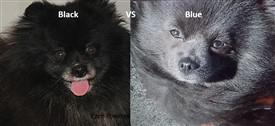
Here are some great photos to show the difference in the black vs the blue nose.
On the left, is a black-coated Pom with a black nose, courtesy of Carol of Keen Pomeranians.
On the right, is the same blue Pom as seen above (but now seen as a 4 year old adult), courtesy of Lora of Pomarazzi Pomeranians.
Take a look at the comparison here. It is often only obvious once you can see it side-by-side.
Here are some great photos to show the difference in the black vs the blue nose. On the left, is a black-coated Pom with a black nose, courtesy of Carol of Keen Pomeranians. On the right, is the same blue Pom as seen above (but now seen as a 4 year old adult), courtesy of Lora of Pomarazzi Pomeranians. Take a look at the comparison here. It is often only obvious once you can see it side-by-side.
Extremely Rare Nose Color, Due to Genetic Blue
There is something remarkably special about white Pomeranians, that is very different than most other dog breeds that can have white coats: With Poms, white is a masking color.
Under the white of every
white Pom, is another color! We do not mean literally, we are speaking genetically. And this is the main reason why breeding for whites is not an easy task; that color can pop out.
So, what you are looking at (photo right on computer/below on mobile) is a white Pomeranian
that is genetically blue.
The blue is diluting the nose. Now, those blue genes are not making the nose blue like the Pom above.
It is, however, altering the color to create this incredibly unique skin color that is hard to find. Only due to experience, did we know this by looking at the photo. When we checked with this Pom's owners, it was confirmed that Frosty's great-grandmother was a blue merle.
Extremely Rare Nose Color, Due to Genetic Blue
There is something remarkably special about white Pomeranians, that is very different than most other dog breeds that can have white coats: With Poms, white is a masking color.
Under the white of every
white Pom, is another color! We do not mean literally, we are speaking genetically. And this is the main reason why breeding for whites is not an easy task; that color can pop out.
So, what you are looking at (photo right on computer/below on mobile) is a white Pomeranian
that is genetically blue. The blue is diluting the nose. Now, those blue genes are not making the nose blue like the Pom above.
It is, however, altering the color to create this incredibly unique skin color that is hard to find. Only due to experience, did we know this by looking at the photo. When we checked with this Pom's owners, it was confirmed that Frosty's great-grandmother was a blue merle.

Frosty, 5 months old
Photo courtesy of Raul and Daima De Los Cuetos from CA
If, hypothetically, this Pom was bred, he could produce blue puppies (and we mean blue coats, not just the nose color!).
Lavender Noses
This is a very rare (even more so than blue) and very lovely color, as you can see here with Zion Pooh Bear (below).
Lavender (both coat and skin pigmentation) is not an accepted color, yet most certainly exists.
And of course, a Pom with this color can be AKC registered (color does not affect that at all). When a breeder produces lavender, since there is no check-off box for this color, that breeder must choose
the color that most closely matches.
It is still not proven what, exactly, produces this rare color. It is, however, thought to be a diluted blue (which itself is a diluted color, as it is a diluted black). Or, it may be tied to a dilute beaver.
Many times, a Pomeranian that is lavender also has chocolate in his/her genes, so we tend to think that somehow chocolate plays a role.
At first glance, one may think that this Pom has a black nose. However, if you compare the noses you will see that this nose is not black at all.
Another comparison would be to chocolate, however the coat gives it away on this one; a chocolate (brown) nose would have a chocolate coat and this fur is clearly diluted. Another comparison would be to blue, however a blue nose would have a steel blue coat.
Most often, a lavender will be registered as a chocolate, however that really depends on the breeder who checked off the box and if they had experience in seeing this color.
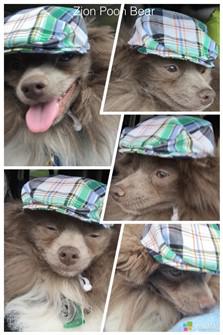
Zion Pooh Bear, Photo courtesy of Paul & Dee Foster
Zion Pooh Bear, 10 months old
Photo courtesy of Paul and Dee Foster

Here is another lavender Pom; to be exact she is a lavender parti (meaning two colors) due to the tan color as well, with a lavender nose.
This is a great image, because it really shows off this incredible, unique color and her nose is bright and shiny.
The nose here is such
a deep lavender color, that it literally is bordering on purple. The soft fur is that heavenly 'washed out', dilute.
Sonya, 11 months old, Photo courtesy of Brittney
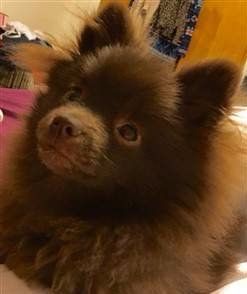

A perfect example of a chocolate Pom with a chocolate nose | Archer, 6 months old
Photo courtesy of Brittany
Chocolate Noses
This is the second most common nose color with the Pomeranian breed. And this is also one of the nose colors that can have a huge amount of variation in its hues.
Chocolate is self-coloring, so a Pomeranian with a chocolate nose will have brown in the coat and also, his eye rims (and lips and paws) will be chocolate.
In
most cases, if you see a Pomeranian with a brown nose, that puppy or dog will clearly have chocolate in the coat, either as a solid or as a parti (two colors).
However,
sometimes, it can be a chocolate
sabling that is present. Sabling refers to dark tipped hairs, and while this is most often seen as black tipped hairs, with some dogs the tipping will be dark brown. The brown will be genetically expressed in both the tipping and the skin pigmentation.
*** If you see a red or orange coat with a brown nose, this means that there is chocolate in the bloodline, that is not being expressed in the coat.
Let's take a look at just how much difference there can be with this nose color.

This beautiful orange sable Pomeranian shows off a dark chocolate nose. The glint of sunlight allows you to see that it is indeed in the brown range and not black.
Pici, RIP
Photo courtesy of Heidi Kimball

This is another dark brown nose (chocolate), and thanks to good photography by this Pom's owners, we can see the brown in the light. We woudn't be surprised that at times, this Pom's nose may appear
to be black, since it is lovely dark brown. Taz, 3 years old, Photo courtesy of Kathy Wyatt

This is the 'classic' chocolate nose for the Pomeranian breed. The milk brown color is seen both on the nose and on the fur.
Pepe, 6 months old
Photo courtesy of the Ketron Family
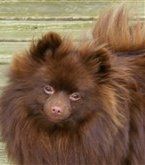
A VERY light chocolate nose color, bordering extremely close to beaver. However, the chocolate (brown) in the coat tells us that this nose is indeed chocolate. Capt. Cubby
Photo courtesy of Cathleen Cook Oas

This cute little brindle is a brown nosed Pomeranian, AKA chocolate.
Chica, 6 months old, Photo courtesy of Els - Belgium
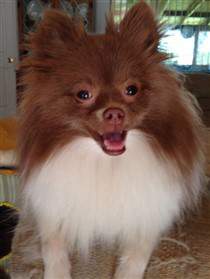
This chocolate parti Pom has a solid chocolate brown nose. The parti factor could
have affected the nose, but it did not.
Ceauxlbie, 2 years old
Photo courtesy of Fran Caiafa
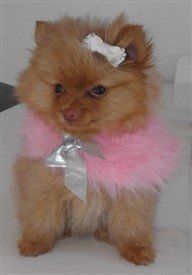
Many would assume this is a beaver nose, but it is a chocolate nose. You can know this by looking at the coat. This is an orange chocolate sable Pom. Sable can be black or chocolate, not beaver. So, the chocolate of the coat makes this a chocolate nose, albeit a very light one! Chocky, 6 months old Photo courtesy of Veronika Uricko

This orange sable parti Pomeranian has a chocolate nose. The 'sable' part of the coat is due to the chocolate gene and therefore, the nose, lips, eye rims are chocolate. There is a slight
touch of another color. With white in the coat, the parti gene is present. And that
can end up landing on the nose, causing a lighter color. Isabella, 15 months old, Photo courtesy of the Stephens Family
Beaver, Parti-Noses and More...
Let's take a look at the remaining Pomeranian nose colors of beaver, parti and more.
Did you enjoy this section about noses?
If so, you should check out what's in the PetPom Book! It's the website times 100~! Available in both print and eBook, it is the most comprehensive Pomeranian care book in the world.
Are You a Member Yet?
Become a Free PetPom Member so that you'll receive a friendly reminder when we add new pages and sections to the site! You will also receive a fun & helpful Welcome Booklet.
You May Also Like:
Helping a Pomeranian with Separation Anxiety
- There are lots of things you can do to help your Pom when he's home alone.
If you email photos to us, you agree that PetPom is given free copyright to use at our discretion. We will always credit the photo to the name of the Pom's owner(s) if it is supplied.
Email: Contact@PetPom.com
All text, images and artwork protected by US and International copyright laws. All rights reserved. Copyright PetPom.com
We are a participant in the Amazon Services LLC Associates Program, an affiliate advertising program designed to provide a means for us to earn fees by linking to Amazon.com and affiliated sites.

